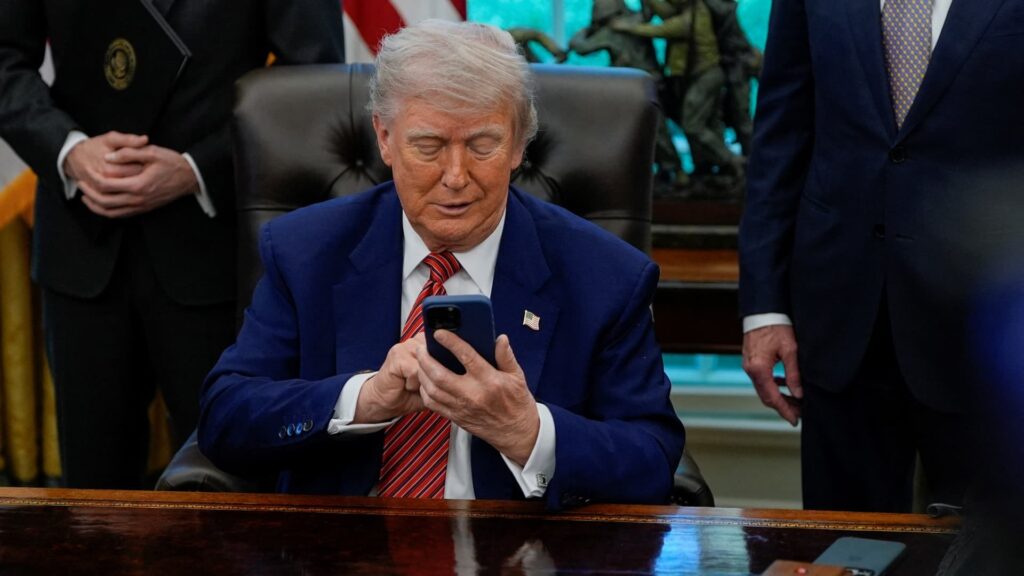U.S. President Donald Trump handles a cellphone after it rang while he was speaking on the day he signs an executive order at the White House in Washington, D.C., U.S., May 23, 2025.
Kent Nishimura | Reuters
If U.S. President Donald Trump follows up on his threat of 50% tariffs on the European Union, he’d be imposing higher duties on America’s ally compared with the 30% on China currently.
But on Sunday, Trump said he would delay tariffs on EU to July 9 from June 1 following a call with European Commission President Ursula von der Leyen.
Indeed, when news of the tariffs first broke, analysts weren’t convinced Trump’s statement held much weight. For one, the U.S. President used the word “recommendation” — a proposal rather than a clear directive. Trump has also walked back on more than one occasion with regard to import duties: pausing the “reciprocal” tariffs and lowering trade barriers with China, albeit both on a temporary basis.
Major U.S. and European stock indexes did not have a sharp reaction compared with Trump’s initial announcement of tariffs on April 2, signaling that investors are beginning to take tariff-related announcements with a pinch of salt.
The proposal of 50% tariff on the EU is primarily a “negotiating tactic,” Barclays wrote in a Friday note.
Still, markets dropped on the week — the S&P 500, Dow Jones Industrial Index and Nasdaq Composite lost more than 2% during that period — as Treasury yields jumped. The sell-off in Treasurys came on the back of Trump’s tax bill, which is estimated to add $2.3 trillion to the federal deficit.
So, while investors appear to be coming to terms with Trump’s tariffs proclamations, there’s much more in the president’s arsenal to keep markets jittery.
What you need to know today
Trump recommends 50% tariffs on EU
U.S. President Donald Trump said Sunday he will delay 50% tariffs on the European Union until July 9, days after “recommending” them to kick in from June 1. Trade freight experts said that such tariffs could “backfire” on the U.S. and make manufacturing more expensive. The White House did not interpret the president’s post as a formal statement of policy, CNBC’s Eamon Javers reported.
U.S. markets dropped — slightly
U.S. stocks dropped Friday on Trump’s tariff threats. The S&P 500 retreated 0.67%, the Dow Jones Industrial Average lost 0.61% and the Nasdaq Composite slid 1%. Those moves, however, are much smaller than the plunges of more than 4% on April 4, after Trump announced his “reciprocal tariffs.” Asia-Pacific markets were mixed Monday. At 2 p.m. Singapore time, Japan’s Nikkei 225 was up nearly 1% as shares of Nippon Steel added 2.2% following news that Trump had approved a merger between the company and U.S. Steel.
Staying ahead despite export curbs
Stockpiling chips, making artificial intelligence models more efficient and using homegrown semiconductors — those are some strategies Chinese technology companies Tencent and Baidu are using to keep up in the global AI race even as the U.S. tightens exports of crucial chips. Nvidia CEO Jensen Huang on Wednesday called the curbs a “failure,” saying they are doing more damage to American businesses than to China.
Xiaomi’s car challenges Tesla’s
Less than a year after launching its first electric car, Xiaomi revealed its YU7 SUV late on Thursday. The company claimed it would have a driving range of at least 760 kilometers (472 miles) on a single charge, taking aim at the Tesla’s extended-range Model Y, which advertises a range of 719 km. “We expect Yu7 would significantly erode Tesla Model-Y’s China market share,” Citi analyst Jeff Chung said in a report Sunday.
[PRO] Nvidia earnings to determine markets
Nvidia announces first-quarter earnings this week. The Wednesday event — alongside comments Trump seemingly shoots from the hip — will determine investor sentiment of markets for the week. Keep an eye out also for the U.S. personal consumption expenditures index for April for signs of how tariffs are affecting the prices households pay for goods and services.
And finally…
The cargo yard of the Qianwan United Container Terminal of Qingdao Port in Qingdao City, Shandong Province, China.
Nurphoto | Getty Images
Businesses are finding a workaround for tariffs — and it’s entirely legal
A decades-old piece of U.S. legislation known as the “first sale rule” allows U.S. importers to use the price of the first sale in a number of transactions to calculate customs duties.
For instance, a Chinese manufacturer sells a T-shirt to a Hong Kong vendor for $5. That Hong Kong vendor sells it to a U.S. retailer for $10. That U.S. retailer then sells the T-shirt to consumers for $40.
Under the first sale rule, the U.S. retailer can pay the import duty on the initial $5 price of the good, rather than the vendor’s inflated $10, thus stripping out the cost associated with the middleman’s profit.
Companies appear to be leveraging that customs law. While the first sale rule is broadly applicable across products and industries, it is considered particularly useful in higher-value consumer goods and luxury products, where margins are greater.

